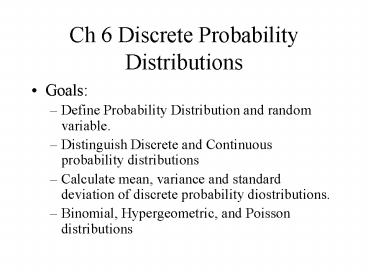Ch 6 Discrete Probability Distributions - PowerPoint PPT Presentation
1 / 12
Title:
Ch 6 Discrete Probability Distributions
Description:
Distinguish Discrete and Continuous probability distributions ... Continuous random variables is 'gap-less' (ref: Dedekin cuts and Cantor sets) ... – PowerPoint PPT presentation
Number of Views:44
Avg rating:3.0/5.0
Title: Ch 6 Discrete Probability Distributions
1
Ch 6 Discrete Probability Distributions
- Goals
- Define Probability Distribution and random
variable. - Distinguish Discrete and Continuous probability
distributions - Calculate mean, variance and standard deviation
of discrete probability diostributions. - Binomial, Hypergeometric, and Poisson
distributions
2
Ch 6 Discrete Probability Distributions
- Defn A random variable is a numeric value
determined by the outcome of an experiment. - Defn A probability distribution is a listing of
all possible outcomes of an experiment and the
probability associated with each outcome.
3
Ch 6 Discrete Probability Distributions
- Properties of Probability Density function, p(X)
where X is a random variable - The sum of all probabilities associated with each
outcome of an experiment is 1 - Sp 1.
- The probability associated with an outcome is
between 0 and 1. - 0lt p lt 1
- Footnote S sum of
4
Ch 6 Discrete Probability Distributions
- Mean SxP(x)
- Variance S(x-µ)2P(x) Sx2 P(x) µ2
- Discrete random variables have gaps between
each data. - Continuous random variables is gap-less (ref
Dedekin cuts and Cantor sets) - Cumulative probability distributions(Excel)
- Footnote S sum of µ population mean
5
Ch 6 Discrete Probability Distributions
Commonly-encountered Distributions
- Discrete distributions well consider 3
- Binomial
- Hypergeometric
- Poisson
- Continuous distribution well consider 1
- Normal
6
Ch 6 Discrete Probability Distributions
- Binomial Distribution
- 2 mutually exclusive categories
- Probability of a success remains same
- Trials are independent
- Count the number of successes in a fixed number
of trials - P(x) nCxpx(1-p)n-x
- Mean np Variance np(1-p)
- Recall nCx n!/(x!n-x!)
- Key descriptive words repetition, with
replacement, bi-names - Footnote p probability of success in a given
trial
7
Binomial Probability Distribution
6-19
- To construct a binomial distribution, let
- n be the number of trials
- x be the number of observed successes
- be the probability of success on each trial
- .. Lets walk-through a binomial experiment
8
.. Lets walk-through a binomial experiment
6-19
- Say roll a die 4 times and look for a 3.
- Here n 4 trials where x 1 success(a 3) was
observed and 1/6 . - What is the probability of this occurring (if we
are not concerned about when in the four rolls it
occurs)?_____(1/6)1(5/6)3_________________ - How many orders can the 3 turn up in 4 rolls of
a die?_____C(4,1)_____ - So, what is the probability of a 3 in 4 trials?
- ___c(4,1) (1/6)1(5/6)3 ___
- What if you wanted to know the probability of 2
3s? - Recall nCx n!/(x!n-x!)
9
Binomial Probability Distribution
6-20
- So, the formula for the binomial probability
distribution is - Recall nCx n!/(x!n-x!)
10
Ch 6 Discrete Probability Distributions
- Hypergeometric Distribution
- Probability of success not the same
- Count the number of successes in a fixed number
of trials - P(x) SCxN-SCn-x/NCn
- Key descriptive words repetition, without
replacement 2-colored balls in urn model
11
Ch 6 Discrete Probability Distributions
- Generalizing the Hypergeometric Distribution
- Probability of success not the same
- Count the number of successes of multiple events
in a fixed number of trials - P(x) SCx RCrN-S-RCn-x-r/NCn
- Key descriptive words repetition, without
replacement 3-colored balls in urn model - Recall nCx n!/(x!n-x!)
12
Ch 6 Discrete Probability Distributions
- Poisson distribution
- Limiting form of the binomial when n is large or
unbounded and p is small. - Assumptions same as binomial.
- P(x) (µxe-µ)/x!
- e 2.71828
- µ Mean np u. avg. successes in an
interval - Mean np Variance
- Key descriptive words repetition, with
replacement aka. Law of Improbable Events - Recall x! x-factorial (eg. 4!4321)































